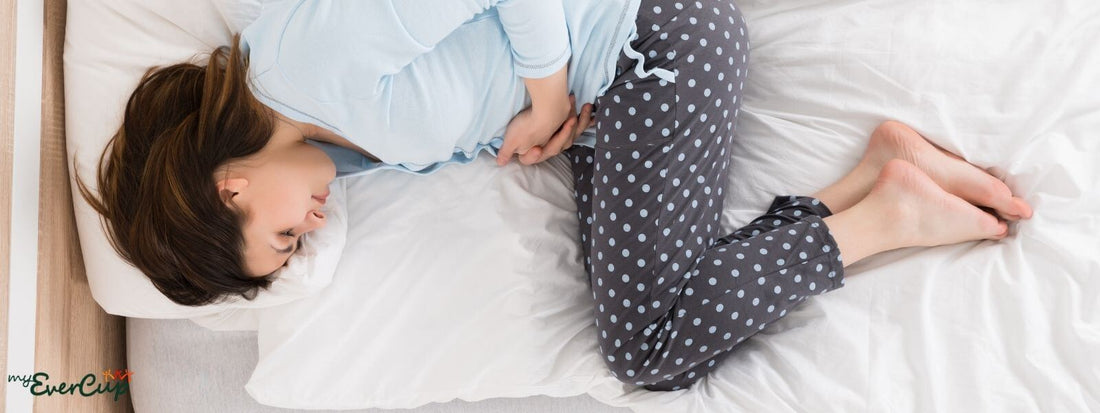PMS symptoms, otherwise known as premenstrual syndrome are a combination of physical, emotional and physiological signs that a woman may experience before menstruation. Though they vary in severity depending on the cycle and the woman, PMS may include depression, cramps, cravings, fatigue, mood swings and much more.
Wondering, what is PMS and am I experiencing PMS symptoms? You’re not alone. Here’s what you need to know about the most common premenstrual indicators and how to reduce them.
Disclaimer: The following was written for informational purposes only and is not medical advice. If you have questions or concerns regarding your health, please speak with your gynecologist.
What Is PMS? 7 Quick Facts
- PMS stands for premenstrual symptoms
- Some of the most common are depression, bloating. Cramps, cravings, breast tenderness, fatigue, and acne.
- Over 90% of women experience it.
- Premenstrual mood swings and physical changes are associated with fluctuating hormone levels.
- There is no “cure” for the side-effects of menstruation, but there are ways to make it easier every month.
- Pregnant women and menopausal women do not experience it, though the former may exhibit similar symptoms due to increased hormone levels.
- The more severe version of PMS symptoms is called PMDD.
PMS Meaning: What Is Premenstrual Syndrome?
PMS or pre-menstrual syndrome is a combination of symptoms that some women experience after ovulation and prior to the beginning of another menstrual cycle. These can include physical and emotional changes, such as depression, anxiety, cramps, tender breasts, fatigue and more. If you are concerned about the severity of these symptoms please contact your physician.
What Cause Premenstrual Syndrome?
These changes are attributed to fluctuating hormone levels after ovulation and before the next menstrual cycle. The main hormones involved in these changes are progesterone and estrogen.
During the follicular phase of the menstrual cycle, a woman’s body produces the follicles that will later store the egg. Simultaneously, the uterine lining will thicken. Next, the egg travels through the fallopian tube to the uterus -- this stage is called ovulation. After ovulation comes the luteal phase in which a woman’s body releases more progesterone and estrogen, two hormones that are crucial to fertility.
When an egg is not fertilized, the body will release it and begin menstruation. Simultaneously, progesterone and estrogen levels will drop, which can lead to a decrease in brain serotonin levels. According to the Hormone Health Network, serotonin can affect a variety of key processes including:
- Mood
- Sleep
- Nausea
- Digestive Health
When one’s serotonin levels decrease, these processes change. For example, depression is often connected to low serotonin levels. Similarly, depression is one of the most common PMS symptoms as a woman’s progesterone levels drop, thereby temporarily affecting her serotonin levels.

How Long Does PMS Last?
Menstruation varies from woman to woman. It tends to happen five days prior to your period for three periods in a row, according to the Office of Women’s Health. These feelings typically dissipate between two days prior to menstruation and the first day of a woman’s menstrual cycle, according to one study.
When Does PMS Start and Who Experiences It?
Some women experience premenstrual symptoms between 5 and 11 days before menstruation. Answering, what is PMS, varies between women and can vary depending on their age, stress level, and other biological factors. For instance, it is common for these conditions to worsen as a woman ages into her 30s and 40s as her hormone levels shift. Additionally, more severe PMS symptoms during menarche -- the first few years of menstruation -- are common.
Women in menopause do not experience these symptoms because they are no longer menstruating. However, hormone fluctuations are common in the years leading up to menopause. Similarly, pregnant women do not experience PMS -- though they may exhibit similar symptoms because of changing progesterone levels due to the pregnancy.
19 PMS Symptoms
The severity of premenstrual conditions varies from woman to woman. Not all women will experience the same symptoms to the same degree or necessarily experience them at all. With that in mind, over 90% of women experience PMS symptoms at some point, according to the Office of Women’s Health. Out of that 80%, between 20-32% of women experience severe symptoms that affect day-to-day activities. Here are a few of the most common examples:
Mood-Related PMS Symptoms:
- Anxiety
- Depression
- Drowsiness
- Emotional upset
- Food cravings
- Irritability
- Mood swings
- Sadness
Physical Premenstrual Indicators:
- Abdominal pain
- Acne
- Appetite changes
- Bloating
- Constipation
- Diarrhea
- Difficulty sleeping
- Gassiness
- Headaches
- Tender breasts
- Sensitivity to pain

What Is Premenstrual Dysphoric Disorder (PMDD)?
PMDD otherwise known as premenstrual dysphoric disorder is similar though more severe. PMDD symptoms appear similar, however, depression, anxiety, and pain may be more intense and require medical attention.
According to one study published in the Journal of Women’s Health, PMDD affects approximately 5 % of women of childbearing age. Women who already experience anxiety and depression may be more prone to intense PMDD and PMS symptoms. If you believe that you suffer from Premenstrual dysphoric disorder, please contact a physician to learn more about diagnosis and treatment options.
How to Treat PMS Symptoms
For many women, it’s impossible to treat premenstrual indicators completely. Rather, it’s a question of preparing for menstruation and taking care of oneself. With that in mind, here are a few things that we have tried to help us get through our hormonal changes.
- Sleep for 8+ Hours a Night: This will improve your mood and reduce fatigue simultaneously.
- Drink Water: This can help reduce bloating, constipation and stay hydrated if you experience diarrhea.
- Exercise: Working out can help reduce anxiety, depression, promote long-life and good memory, according to many studies, including this one published in Frontiers of Psychiatry. It can also help reduce bloating.
- Eat a Balanced Diet: Keep in mind that the body is losing iron during menstruation. Failing to replace it through diet or supplements can lead to anemia, as demonstrated by research in Lab Medicine.
- Chart Your Period: For some women, using a period tracker app helps them know when to expect PMS symptoms. This can help them prepare mentally and physically to lessen their impact.
- Stop Drinking Caffeine: Caffeine has been shown to increase the severity of premenstrual cycle conditions, according to a study published in the American Journal of Public Health. Not only can it make cramps worse, but coffee and tea can worsen diarrhea, another common condition.
Common Medications to Assuage Cramps
Several over-the-counter medications are commonly used to reduce cramps and discomfort. These include ibuprofen, Midol, Advil, and Motrin, among others. Some women who experience severe PMS symptoms may choose to take hormonal birth control, which balances hormonal fluctuations. These include oral contraception such as the pill and the hormonal IUD. Choosing to take birth control to assuage side-effects is a personal choice that should be made with a gynecologist.
Similarly, anti-depressants, which affect serotonin levels on the brain, can also be used to treat symptoms similar to those of pre-menstruation. However, these medications are typically prescribed for women with histories of anxiety and depression. Please discuss antidepressants with a licensed medical professional.
PMS Meaning: Pre-Menstruation Is Different for Everyone
What Is PMS? For over 90% of women, it’s a monthly occurrence that can affect work, school, and general comfort level. The days leading up to a woman’s period can mean mood swings, cramps, tenderness, and digestive troubles. But luckily, you’re not alone: millions of other women have found that these symptoms can be assuaged through a balanced diet, rest, hydration, and preparation

